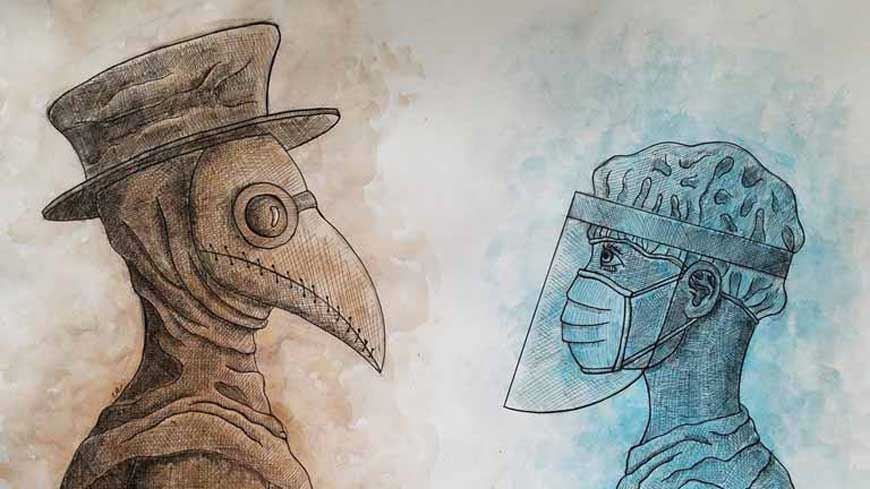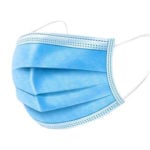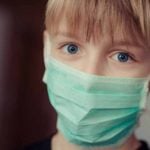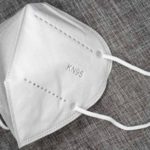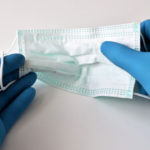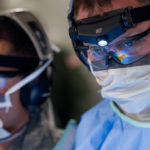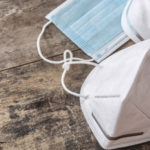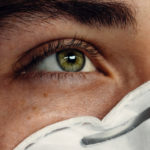Image credit: C.H. Engelhardt. View their work here.
New reports suggest ongoing shortages of meltblown textiles, a critical ingredient for producing masks like the N95.
Masks were not always made from advanced textiles and multilayer construction. What makes these materials so meaningful when manufacturing PPE equipment, and how has mask technology changed over time?
Simple or Sinister? The Origin Story of Medical Face Masks
Most recognize the ominous images of so-called “beak doctors” from the middle ages. The masks covered the entire head and featured a bird-shaped beak with two eye holes. The beak was said to be stuffed with sweet-smelling dried flowers, herbs, and spices.
During the Black Death, which lasted from 1347 to 1350, interventional treatments and prevention methods were little understood.
Before modern germ theory, Miasma theory suggested that that sickness and diseases like the Black Plague were spread by poor or foul-smelling air. Some characterized these “beak masks” as sinister, terrifying, and ritualistic, but did they work?
It’s reasonable that much like masks or face shields, head coverings limited the touching of one’s face and reduced bubonic droplet transmissions while Plague Doctors administered “protective concoctions”, “antidotes”, living wills, or autopsies.
The Simple Explanation
Others suggest that “plague-doctors with beak-like masks” never existed at all. Textual references were not described until nearly 300 years after the bubonic plague killed nearly a third of Europeans. Despite the esoteric costume and grim imagery, the plague mask may have shaped attitudes around the 16th-century equivalents of modern-day hazmat suits and face shields.
Finding Reason and Science Among Invisible Pathogens
Historically, humans have battled the invisible forces of pandemics for all of time. Some cultures thought that disease spread through glancing looks, spirits, acts of God, celestial phenomena, or random events. Insights remained limited until microscopes confirmed the presence of “animalcules” in the mid-17th century, a Latin reference to “little animals” that we now call microorganisms. The science of droplet infections did not emerge until near the end of the 20th century.
Emerging Technology and Production Capabilities
In the early 20th century, multi-layer cotton gauze masks provided significant protection, but heavy weight materials lacked comfort and breathability. Masks slowly evolved to multi-layer constructions as the study of germ content continued. Surgical masks were not commonplace until 1910.
How We Got to Today
Even following the First World War, masks and gloves were rejected as irritating and intrusive. During the 1918 flu, protests and petitions against mask requirements were emblematic of disdain for government overreach and medical authority.
Between the 1930s and 1960s, disposable paper masks were upgraded to synthetic non-woven fibers which replaced the need for washable and sterilizable masks.
Recent studies show masks with high-density synthetic layers provide superior performance compared to artisanal and homemade masks.
Continue Reading: Masks, Schools, and Education: What Does the Data Say?
Addressing Today’s Challenges and Face Mask Shortages
As observed during the grip of a pandemic, better performing alternatives are not always widely available. Last month, the FDA created its first-ever medical supply shortage list.
In the absence of N95 masks, the FDA has approved a number of KN95 masks from authorized manufacturers.
As the flu season and COVID-19 pandemic merge in the coming winter, some have testified that without better planning, 2020 could be the darkest winter in modern history.
Shop COVID Spread Prevention Solutions Online
While inventory levels can and will change, in stock products for PAC customers include 3-Ply Face Masks, FDA Authorized KN95s, Hand Sanitizer, Isopropyl Alcohol, Presaturated Wipes, and Workspace Dividers.
Production Automation Corporation (PAC) is an essential supplier of manufacturing equipment, supplies, and environmental controls.
We have face masks currently in stock at warehouses across the United States. As warehouse inventory is cycled and restocked, the exact specifications may vary. Stock levels change daily. Have questions? Post your comment below. (Sí, se habla español)
Procedural Masks
- 3 Layer Mask
- PP + Spunbond Layers
- No Latex
- No Fiberglass
- Ear Loops
- Soft Lining and Breathable
KN95
- Disposable non-surgical face masks.
- Designed for everyday civilian use.
- 95% filtration efficacy
- Filters out particles, dust, droplets, etc.
- 3rd-party tested and validated
- Comfortable ear loops
Image credit: C.H. Engelhardt. View their work here.
Related Posts
-
What's a Medical Mask? Why is It Different from a Procedural Mask?
Medical masks by definition, must be validated at a minimum of ASTM Level 1.
-
Where Can I Buy FDA Approved KN95 Masks?
When you buy face masks from PAC you'll have the benefit of masks shipped from USA warehouses, in-stock availability, and bulk pricing.
-
Where to Buy Bulk 3 Ply Face Masks In Stock August 2020
Production Automation Corporation (PAC - that's us) currently has received new inventory of in-stock procedural face masks, ready to ship.
-
Why 3-Ply Face Masks are Meaningful Alternatives to N95 Masks
How effective are surgical masks and procedural masks as alternatives to N95 masks? Where can I find a reliable supplier of face masks?
-
Face Mask Definitions & Terms
Define surgical mask, filtering respirator, 3 ply mask, and medical mask.
-
What are the Standards for ASTM Face Mask Testing?
This post will help you understand the context, performance criteria, and minimum requirements of ASTM levels in various medical masks and their respective uses fields. ASTM General Overview ASTM is the american society for testing…
-
Where to Buy Bulk 3 Ply Face Masks In Stock August 2020
Production Automation Corporation (PAC - that's us) currently has received new inventory of in-stock procedural face masks, ready to ship.
-
What's a Medical Mask? Why is It Different from a Procedural Mask?
Medical masks by definition, must be validated at a minimum of ASTM Level 1.
-
Surgical Medical Masks ASTM Level 3 Requirements
This post will help you understand meaningful differences between various face mask evaluation methods and best-case use. Understanding the most common mask materials and expected performance metrics helps buyers better decide which mask is most…
-
Why 3-Ply Face Masks are Meaningful Alternatives to N95 Masks
How effective are surgical masks and procedural masks as alternatives to N95 masks? Where can I find a reliable supplier of face masks?
-
Face Masks in 2022: It's Time to Update Your Knowledge About Face Masks
It’s been a year since the COVID-19 pandemic started and it looks like face masks are not going away anytime soon. With the pandemic continuing, this is the year to update your knowledge about face…
-
Face Masks in 2022: It's Time to Update Your Knowledge About Face Masks
It’s been a year since the COVID-19 pandemic started and it looks like face masks are not going away anytime soon. With the pandemic continuing, this is the year to update your knowledge about face…
-
Droplets vs Airborne - Science of Airborne Droplets, Aerosols, Particles, and Face Masks
Aerosols vs Droplets - does COVID-19 spread by aerosols or droplets? Does evidence support airborne coronavirus? 15+ studies on COVID particle size, droplets, ventilation, and face masks.
-
FDA Cleanroom Requirements for Face Masks, Surgical Gowns and PPE Production
Question: “What Class clean room is required to manufacture FDA approved N95 masks, isolation gowns, surgical masks, etc.?”.
-
Surgical Medical Masks ASTM Level 3 Requirements
This post will help you understand meaningful differences between various face mask evaluation methods and best-case use. Understanding the most common mask materials and expected performance metrics helps buyers better decide which mask is most…

